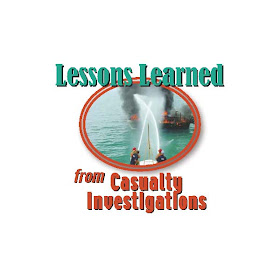 Excerpt from U.S. Coast Guard “Proceedings of the Marine Safety & Security Council” magazine by Captain Brendan Saburn, U.S. Coast Guard Office of Investigations and Casualty Analysis.
Excerpt from U.S. Coast Guard “Proceedings of the Marine Safety & Security Council” magazine by Captain Brendan Saburn, U.S. Coast Guard Office of Investigations and Casualty Analysis.Lessons learned from USCG marine casualty reports are regularly featured in Proceedings of the Marine Safety & Security Council magazine. These articles explore marine incidents and the causal factors, outline the subsequent U.S. Coast Guard marine casualty investigations, and describe the lessons learned as a result.
It is important to note that lives were lost in some of the marine casualties we present. Out of respect for the deceased, their families, and surviving crewmembers, we do not mention the name of any person involved.
On December 9, 2003, the 289-foot heavy-lift freighter Stellamare capsized and sank in Albany, N.Y., while loading a 308-metric-ton generator. This marine casualty, which resulted in the deaths of three of the ship’s crew, was caused by improper ballasting and the speed of cargo handling.
The operation of a small heavy-lift ship is highly specialized. This is a ship less than 300 feet long, whose deadweight tonnage is only 2,760 metric tons, with cargo gear capable of lifting a total of 360 tons. This ship was fitted with two heavy-lift derricks, each of which was rated for a safe working load of 180 metric tons, so a combined load of 360 tons was permissible.
Two generators were to be loaded aboard this ship that day. One weighed 308 metric tons, the other 234 metric tons. During operations, the smaller generator was loaded as planned. It was loaded first, onto what had been an empty ship, to make the ship more stable in preparation for the heavier generator.
Stability: An Illustration
It’s important to understand what is meant by “stability.” There are three states of stability: stable, neutral, and unstable. Think of a child in a rocking chair. The chair rocking forward and backward is analogous to a ship rolling to starboard and port. If the child is sitting, the chair is very stable and can be rocked back and forth, but won’t topple over forward or backward because the center of gravity of the child and chair combination is down low.
But what if the child decides to kneel? Then the chair will be in “neutral” equilibrium. If the child leans forward, there is neither a tendency for the chair to return to the upright position nor a tendency for the chair to topple. The chair will stay where the child positions himself while kneeling.
If the child stands up in the chair, the center of gravity of the child and chair combination is now too high—unstable equilibrium. If the standing child moves too far forward or backwards, the chair can topple.
Let’s continue our example. How can we make the chair more stable so the child can’t upset it by standing? One way would be to fasten bricks to the underside of the chair, which would add weight below the desired center of gravity. In other words, we could “ballast” the rocking chair. We could also lengthen the chair’s rockers, which would be analogous to making a ship wider.
In Part II, we will examine how these principles were used in the failed loading operation.
For more information:
Full article is available at www.uscg.mil/proceedings. Click on “archives” and "2008 Volume 65, Number 2" (Summer 2008).
Subscribe online at http://www.uscg.mil/proceedings/subscribe.asp.
Direct requests for print copies of this edition to: HQS-DG-NMCProceedings@uscg.mil.
No comments:
Post a Comment
Comment Policy
We welcome your comments on postings at all Coast Guard sites/journals. These are sponsored by the U.S. Coast Guard to provide a forum to talk about our work providing maritime safety, security and stewardship for the American people to secure the homeland, save lives and property, protect the environment, and promote economic prosperity.
Please note: Anonymous comments have been disabled for this journal. It is preferred that you use your real name when posting a comment. WE WILL POST THE NAME YOU ENTER WHEN YOU SUBMIT YOUR COMMENT. Also, you are welcome to use Open ID or other user technologies that may be available.
All comments submitted are moderated and will be reviewed before posting. The Coast Guard retains the discretion to determine which comments it will post and which it will not. We expect all contributors to be respectful. We will not post comments that contain personal attacks of any kind; refer to Coast Guard or other employees by name; contain offensive terms that target specific ethnic or racial groups, or contain vulgar language. We will also not post comments that are spam, are clearly off topic or that promote services or products.
We will make our best effort to promptly post those comments that are consistent with the Comment Policy, but given the need to manage federal resources, moderating and posting of comments will usually occur only during regular business hours, Monday through Friday. Comments submitted outside of business hours will be read and posted as quickly as possible.